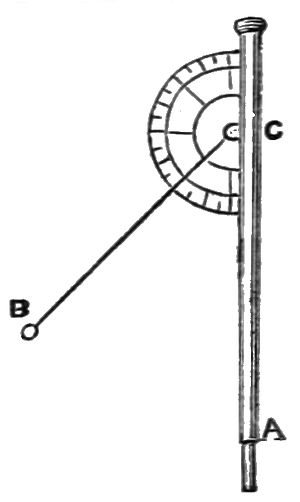If no point exist on the conductor, a single turn of the handle of the machine suffices to cause the straw to stand out nearly at right angles to the stem. If, on the contrary, a point be attached to the conductor, you cannot produce a large divergence. The reason is, that the electricity, as fast as it is generated, is dispersed by the point. The same effect is observed when you present a point to the

Fig. 20.
conductor. The conductor acts by induction upon the point, causing the negative electricity to stream from it against the conductor, which is thus neutralized almost as fast as it is charged. Flames and glowing embers act like points; they also rapidly discharge electricity.
The electricity escaping from a point or flame into the air renders the air self-repulsive. The consequence is that, when the hand is placed over a point mounted on the prime conductor of a machine in good action, a cold blast is distinctly felt. Dr. Watson noticed this blast from a flame placed on an electrified conductor, while Wilson noticed the blast from a point. Jallabert and the Abbé Nollet also observed and described the influence of points and flames. The blast is called the "electric wind." Wilson moved bodies by its action; Faraday caused it to depress the surface of a liquid; Hamilton employed the reaction of the electric wind to make pointed wires rotate. The "wind" was also found to promote evaporation.
Hamilton's apparatus is called the "electric mill." Make one for yourself thus: Place two straws S S, S' S', Fig. 21, about eight inches long, across each other at a right angle. Stick them together at their centres by a bit of sealing-wax. Pass a fine wire through each straw and bend it where it issues from the straw, so as to form a little pointed arm perpendicular to the straw, and from half an inch to three-quarters of an inch long. It is easy, by means of a bit of cork or sealing-wax, to fix the wire so that the little bent arms shall point not upward or downward, but sideways, when the cross is horizontal. The points of sewing-needles may also be employed for the bent arms. A little bit of straw is stuck into the cross at the centre, to form a cap. This slips over a sewing-needle, N, supported by a stick of

